GA Serves America: The more the merrier
Cloud Nine and its founder take animal rescue to new heights
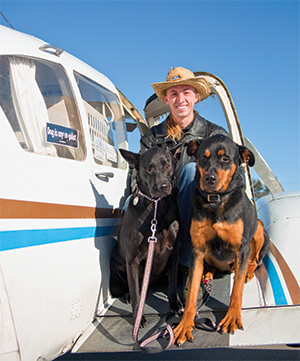 Stickers on the right-side windows of the 1969 Piper Aztec read “General Aviation Serves America” and “Dog is my Co-pilot.” Two different themes, but taken together they represent everything Ted DuPuis set out to do when he became a pilot.
Stickers on the right-side windows of the 1969 Piper Aztec read “General Aviation Serves America” and “Dog is my Co-pilot.” Two different themes, but taken together they represent everything Ted DuPuis set out to do when he became a pilot.
N6927Y is the flagship of Cloud Nine Rescue Flights. Founded in 2009 with the intention of conducting animal rescue and humanitarian flights, Cloud Nine has evolved into an organization that seeks to fulfill a specific niche. When Cloud Nine flies animals, it flies a lot—typically 12 to 15 dogs and cats at a time. And it can, and has, transported many more.
“I bought the Aztec with the idea of starting a rescue group,” says DuPuis. “I wanted to do something that would require a large, capable airplane.” He can remove the Aztec’s seats in 10 minutes, and the back of the Aztec can be loaded with 13 animal crates—eight large, one medium, and four small.
On any given weekend, N6927Y, DuPuis, and sometimes a co-pilot are flying dogs and cats in need of homes. The animals are pulled from shelters or puppy mills and brought to foster and adoption groups. The usual pick-up point is in South Carolina, a part of the country notorious for euthanizing high numbers of animals. The usual drop-off point is in New Hampshire. From its Mid-Atlantic base Cloud Nine has traveled as far as California, as well as to Mexico and Canada.
In January Cloud Nine flew 48 chihuahuas from San Bernardino, California, to Farmingdale, New York. The flight took 14 hours door to door. “They were very well behaved,” DuPuis says of the dogs. “They went to sleep. It was actually a very easy flight.”
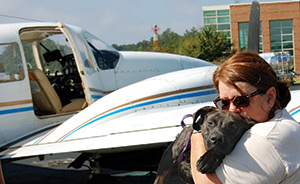 The Mexico mission—to rescue 15 dogs and two cats that had been living at a Cozumel garbage dump—was a greater challenge. The trip required flying over a long stretch of water, which meant carrying a life raft that could hold three people and the animals; learning and anticipating weather trends in the Gulf of Mexico; and dealing with eAPIS. DuPuis flew 48 hours in one week, delivering nine dogs to Colorado and six dogs and two cats to the East Coast.
The Mexico mission—to rescue 15 dogs and two cats that had been living at a Cozumel garbage dump—was a greater challenge. The trip required flying over a long stretch of water, which meant carrying a life raft that could hold three people and the animals; learning and anticipating weather trends in the Gulf of Mexico; and dealing with eAPIS. DuPuis flew 48 hours in one week, delivering nine dogs to Colorado and six dogs and two cats to the East Coast.
The Aztec sits outside its hangar at Williamsport Regional Airport in Pennsylvania, the home base of Cloud Nine. DuPuis and two visitors climb in for a local flight on a warm August evening. At startup, the Lycoming engines rumble smoothly to life. A tower controller advises that there are numerous “flocks of small birds” in the vicinity of the otherwise-quiet airport. They turn out to be starlings on the move.
“This is a great all-around airplane that will do anything you ask it to do,” DuPuis says affectionately. N6927Y will cruise at 6,000 feet on one engine, he says. He has landed it on 3,500-foot airstrips with the “proverbial 50-foot obstacle at either end,” with full fuel and passengers—and no problems. Its rough exterior and pitted nose cone are badges of honor. “It reminds me that the airplane knows more than I do,” he says. In 41 years, N6927Y has flown 10,000 hours—“a lot more time than I’ve got,” he notes.
DuPuis, 28, wasn’t at all inclined to learn to fly. As a high school senior in New York, he witnessed the terrorist attacks of September 11, 2001. “I didn’t get on a commercial flight for four years,” he recalls. A self-described “engine guy” who worked on Jaguars, he accepted a job with an aerospace company after college. A co-worker took him on an introductory flight, and that was it. At 10 hours of training, he had his first flight in an Aztec and decided he wanted a twin.
He became a private pilot in March 2008 and has since acquired flight instructor and commercial certificates and single- and multiengine instrument ratings. He estimates he has logged a hair under 1,000 hours in three years.
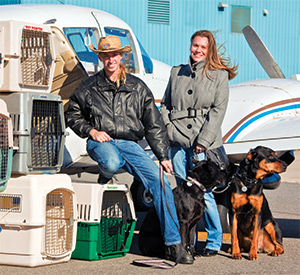 DuPuis began volunteering with Animal Rescue Flights as a means of building time to qualify for Angel Flight missions. When he saw a need for transporting larger numbers of animals—tasks that the volunteer pilots of ARF, Pilots ’n Paws, and other groups typically aren’t equipped to handle—the idea for Cloud Nine was born. Its first mission was in August 2009 as part of the Georgia Puppy Caravan, an event in which airplanes and cars moved an entire shelter’s worth of dogs from Georgia to New Jersey. DuPuis made two trips and flew 40 dogs; the Aztec sustained a total electrical failure during one of the flights.
DuPuis began volunteering with Animal Rescue Flights as a means of building time to qualify for Angel Flight missions. When he saw a need for transporting larger numbers of animals—tasks that the volunteer pilots of ARF, Pilots ’n Paws, and other groups typically aren’t equipped to handle—the idea for Cloud Nine was born. Its first mission was in August 2009 as part of the Georgia Puppy Caravan, an event in which airplanes and cars moved an entire shelter’s worth of dogs from Georgia to New Jersey. DuPuis made two trips and flew 40 dogs; the Aztec sustained a total electrical failure during one of the flights.
Since then, Cloud Nine has completed more than 40 flights and transported more than 400 animals using a volunteer staff of 10, including three pilots. DuPuis is Cloud Nine’s founder and chief pilot, but he does not pay himself a salary.
A typical transport costs about $2,500 total. The “honest hourly cost” for the Aztec is $220, DuPuis says, which translates to about $130 per dog on a standard transport, including deadhead legs.
“It is fun and very rewarding, but it’s a job,” he says. “I have a schedule. I have people on the sending end who are expecting me to arrive at this time. The dogs have to be prepped…the people on the receiving end are planning their day around being at the airport to pick up the dogs.” He views himself “just like the charter pilot flying a King Air, and I have the same challenges of weather, and the bigger challenges of fitting the dogs in [the airplane].” There are days when he doesn’t want to go—days when he’d rather stay in bed. “Well, tough. I’ve made a commitment; I’m going to do it. That’s my attitude.”
The flight over the gently rolling hills around Williamsport concludes with the touch of wheels on the runway. DuPuis takes a few moments to introduce a new addition to the Cloud Nine fleet: N488SP, a Cessna 310 dubbed Sugar Pop. He describes how Cloud Nine acquired it, with the tone of someone who still can’t quite believe his good fortune.
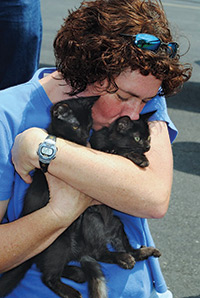 Returning from a rescue flight, he had taxied the Aztec to its hangar and shut down. A pilot named Mark Ziegenfuss saw him moving crates from the back of the airplane into his truck. “He saw the dog cages, came up and said ‘Hi, what do you do, fly dogs?’” The two got to talking.
Returning from a rescue flight, he had taxied the Aztec to its hangar and shut down. A pilot named Mark Ziegenfuss saw him moving crates from the back of the airplane into his truck. “He saw the dog cages, came up and said ‘Hi, what do you do, fly dogs?’” The two got to talking.
Ziegenfuss owned a 1968 Cessna T-310N that he had been trying to sell. Unsuccessful at finding a buyer, a few months later he contacted DuPuis and offered to donate the airplane to Cloud Nine.
“He had the airplane for 25 years,” DuPuis says. “He didn’t want to see it get scrapped, he wanted to see it flown.”
Sugar Pop is not quite as large as the Aztec, DuPuis notes. On its maiden flight for Cloud Nine, it carried 13 dogs and five cats. But it has a Colemill Executive 600-horsepower conversion and trues out at 190 knots. And it has an aftermarket deicing system. Both features make it especially desirable for longer missions. And DuPuis is ready to take on those challenges. But he rejects the notion that what he is doing is somehow special.
“I’m just a guy with an airplane,” he says. “I’m just somebody going out there and trying to make a difference. I’ve been fortunate enough to be put in a position where I can. Cloud Nine was a very planned part of that.”
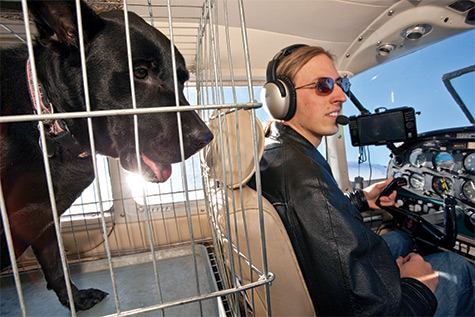
E-mail the author at [email protected].


